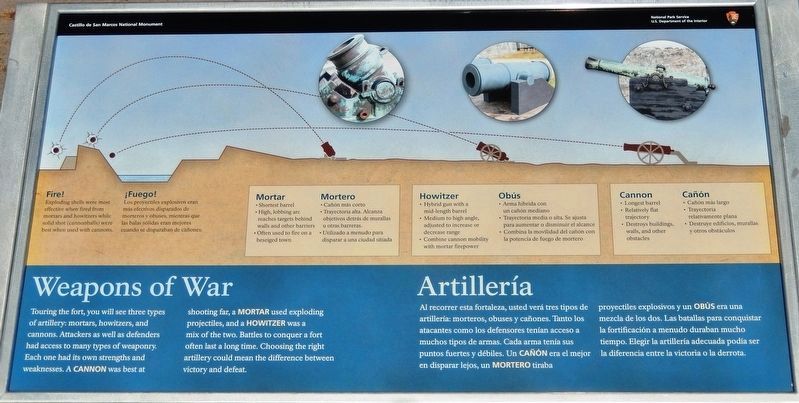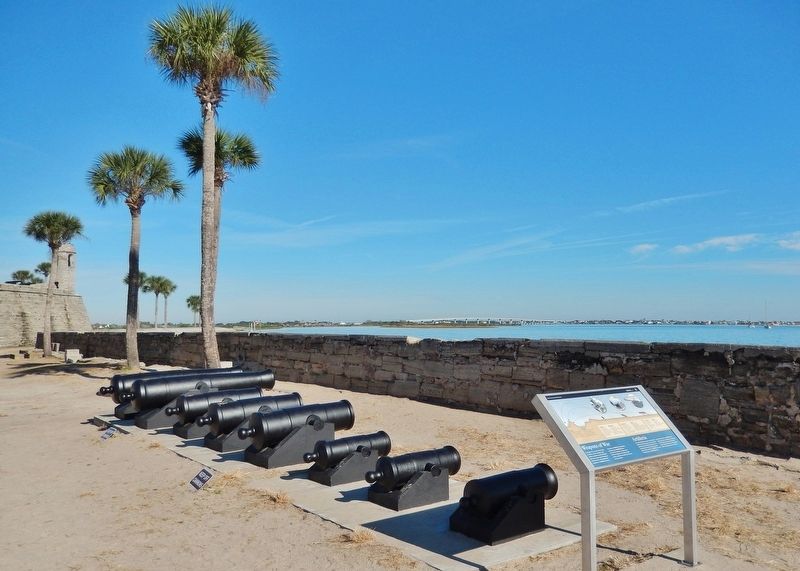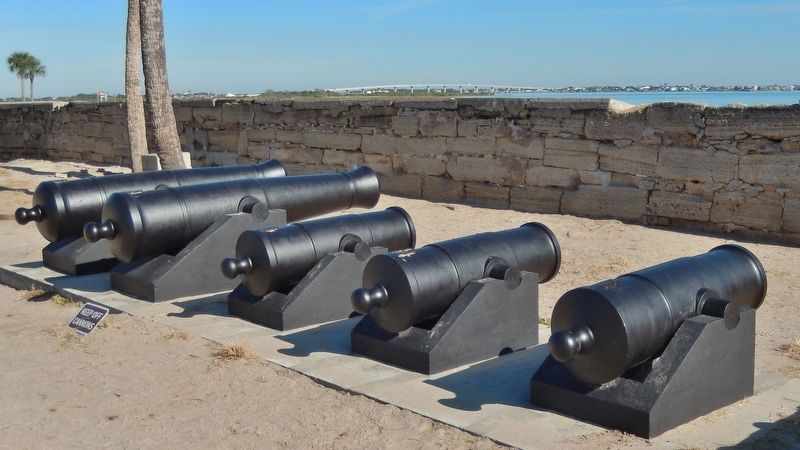St. Augustine in St. Johns County, Florida — The American South (South Atlantic)
Weapons of War / Artillería
Castillo de San Marcos National Monument
Fire!
Exploding shells were most effective when fired from mortars and howitzers while solid shot (cannonballs) were best when used with cannons.
Mortar
• Shortest barrel
• High, lobbing arc reaches targets behind walls and other barriers
• Often used to fire on a besieged town
Howitzer
• Hybrid gun with a mid-length barrel
• Medium to high angle, adjusted to increase or decrease range
• Combine cannon mobility with mortar firepower
Cannon
• Longest barrel
• Relatively flat trajectory
• Destroys buildings, walls, and other obstacles <
¡Fuego!
Los proyectiles explosivos eran más efectivos disparados de morteros y obuses, mientras que las balas sólidas eran mejores cuando se disparaban de cañones.
Mortero
• Cañón más corto
• Trayectoria alta. Alcanza objetivos detrás de murallas u otras barreras.
• Utilizado a menudo para disparar a una ciudad sitiada
Obús
• Arma híbrida con un cañón mediano
• Trayectoria media o alta. Se ajusta para aumentar o disminuir el alcance
• Combina la movilidad del cañón con la potencia de fuego de mortero
Cañón
• Cañón más largo
• Trayectoria relativamente plana
• Destruye edificios, murallas y otros obstáculos
Erected 2018 by National Park
Service, U.S. Department of the Interior.
Topics. This historical marker is listed in these topic lists: Colonial Era • Forts and Castles • Military.
Location. 29° 53.835′ N, 81° 18.651′ W. Marker is in St. Augustine, Florida, in St. Johns County. Marker can be reached from the intersection of South Castillo Drive (State Road A1A) (Business U.S. 1) and Cuna Street, on the right when traveling north. Marker is located on the Castillo de San Marcos National Monument grounds, near the southeast corner of the fort and the San Agustin Bastion, along the beach near the seawall. Touch for map. Marker is at or near this postal address: 1 South Castillo Drive, Saint Augustine FL 32084, United States of America. Touch for directions.
Other nearby markers. At least 8 other markers are within walking distance of this marker. Fort Marion (here, next to this marker); Multi-Use Moat / ¿Un foso sin agua? (a few steps from this marker); Spanish Stronghold / Ciudadela española (within shouting distance of this marker); Sentry Box (within shouting distance of this marker); Covered Way (within shouting distance of this marker); Crumbling Coquina / Piedra frágil (within shouting distance of this marker); Guarding the Back Door / Vigilando dos entradas (within shouting distance of this
marker); Fortress Facelift / Nuevo dueño, obras nuevas (within shouting distance of this marker). Touch for a list and map of all markers in St. Augustine.
More about this marker. Marker is a large rectangular composite plaque, mounted horizontally on waist-high metal posts. There are two instances of this marker on the Castillo de San Marcos National Monument grounds, at two different locations, and near exhibits of two different collections of artillery.
Related markers. Click here for a list of markers that are related to this marker. Castillo de San Marcos National Monument
Also see . . .
1. Arms & Armament. Both bronze and iron were used to make cannons throughout the 18th and 19th centuries. Most fortifications preferred the iron. However, iron was more vulnerable to the elements and rusted easily. Iron guns would become brittle and dangerous over a short period of time and were subject to exploding. When expended, an iron cannon was scrapped. Bronze, although heavier, withstood the stress of firing much better, and less metal was needed to construct the weapon. The non-rusting bronze was preferred for the damp environments of ships and seacoast forts. A bronze cannon had nearly twice the life expectancy of an iron gun, and once expended, the bronze could be melted down and recast into a new weapon. (Submitted on December 14, 2018, by Cosmos Mariner of Cape Canaveral, Florida.)
2. Castillo de San Marcos Artillery Tour. Inventory and location of artillery on display at Castillo de San Marcos. (Submitted on December 14, 2018, by Cosmos Mariner of Cape Canaveral, Florida.)
Credits. This page was last revised on March 20, 2022. It was originally submitted on December 14, 2018, by Cosmos Mariner of Cape Canaveral, Florida. This page has been viewed 239 times since then and 21 times this year. Last updated on March 19, 2022, by Andrea Capps of Lake in the Hills, Illinois. Photos: 1, 2, 3. submitted on December 14, 2018, by Cosmos Mariner of Cape Canaveral, Florida. • J. Makali Bruton was the editor who published this page.


